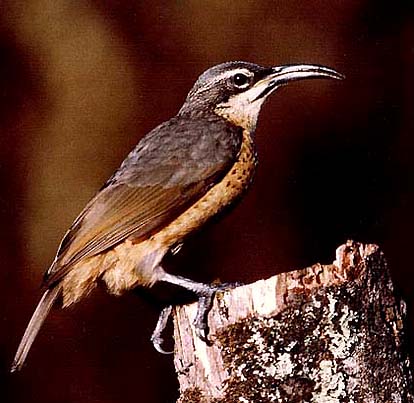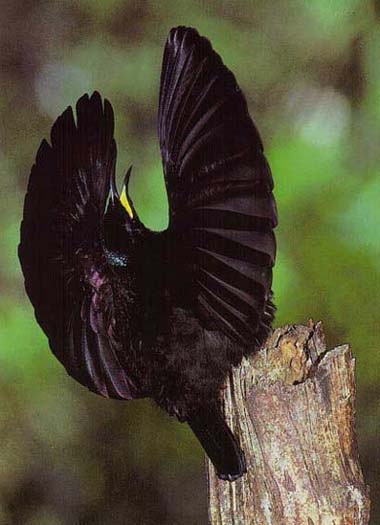
a web page by Don Roberson |
BIRDS-OF-PARADISE Paradisaeidae |
|||||
|
|||||
Perhaps the most famous members of the family are in the genus Paradisaea, including Blue Bird-of-Paradise (left and below). I've chosen it among the "best birds of the world" because it is spectacular; has an unworldly "upside-down" display (which I saw in my visit New Guinea visit in 1983); and the fact that it is limited to a very small montane area of Papua New Guinea. I finally got photos on my third New Guinea visit (2016), illustrated the fruit-eating propensities of the family (left) and its extraordinary tail (below).
|
|||||
 |
|||||
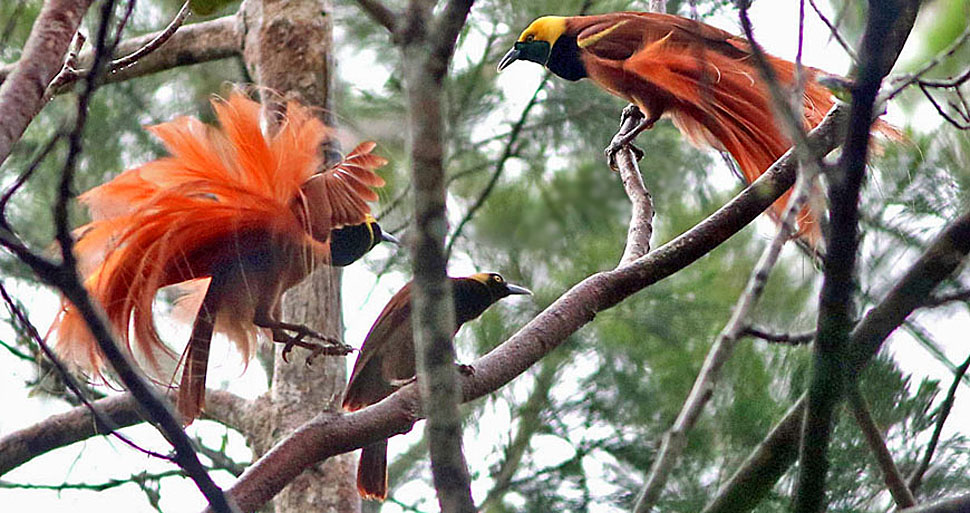 |
|||||
There are seven species in genus Paradisaea, and most of them are lekking species, including the glowing Raggiana Bird-of-Paradise (above). These traditional leks are used year after year. In Raggiana Bird-of-Paradise the lek is at mid-canopy where males can jump, bounce, and shake their exquisite plumes. Here (above) a female has arrived to watch — she's the brown unplumed bird in the center, surrounded by two displaying males. There are "better" perches than others, and the male on the "best" perch usually gets the female. It may take years for another male to dislodge the prime male. In theory, male birds-of-paradise developed all these incredible ornaments and displays because of female sexual selection. In a land where babies can be raised and defended by females alone, a male is not needed to help feed the young or protect them. Females do these functions, and have evolved protective coloration to keep themselves inconspicuous. But they chose to mate with the most gaudy male available. Males, in turn, spend almost all their time trying to attract females. This has created incredible sexual dimorphism in the Paradisaeidae, and promoted rapid evolution in male plumages (Christidis & Schodde 1993). |
|||||
 Because of their spectacular plumages and displays, I included four species of birds-of-paradise ["BOPs" in birder lingo] among my choices for the "best birds in the world" project — more than any other family of birds. Yet the gorgeously red-plumaged Paradisaea birds-of-paradise are not among these choices. Only the Blue Bird-of-Paradise made the cut among genus Paradisaea. For the others I considered BOPs in genera Parotia, Cicinnurus, Drepanornis, Epimachus, and Semioptera. Those in the first two genera perform incredible displays on carefully tended dancing grounds on the forest floor. The Drepanornis sicklebills have inverted poses high in a display tree while Epimachus sicklebills and Semioptera standardwing distort into unworldly poses. These displays are rarely witnessed. For the forest-floor dancers, one must have a blind (which locals construct out of forest materials on the spot) and a lot of time and patience. The first films of dancing parotias were acquired in the 1990s and now highlight the BBC film Attenborough in Paradise (the best bird film I have ever seen). My friend Will Betz, working with National Geographic, obtained this shot of a Carola's Parotia in full display (right), dancing in its "cape" on the forest floor. Limits of this web media preclude seeing details shown in the original photo, such as the six thin wires being waved from the crown. You must see the BBC video to observe the frenzy to which the male works himself up in his incredible performance. Because of their spectacular plumages and displays, I included four species of birds-of-paradise ["BOPs" in birder lingo] among my choices for the "best birds in the world" project — more than any other family of birds. Yet the gorgeously red-plumaged Paradisaea birds-of-paradise are not among these choices. Only the Blue Bird-of-Paradise made the cut among genus Paradisaea. For the others I considered BOPs in genera Parotia, Cicinnurus, Drepanornis, Epimachus, and Semioptera. Those in the first two genera perform incredible displays on carefully tended dancing grounds on the forest floor. The Drepanornis sicklebills have inverted poses high in a display tree while Epimachus sicklebills and Semioptera standardwing distort into unworldly poses. These displays are rarely witnessed. For the forest-floor dancers, one must have a blind (which locals construct out of forest materials on the spot) and a lot of time and patience. The first films of dancing parotias were acquired in the 1990s and now highlight the BBC film Attenborough in Paradise (the best bird film I have ever seen). My friend Will Betz, working with National Geographic, obtained this shot of a Carola's Parotia in full display (right), dancing in its "cape" on the forest floor. Limits of this web media preclude seeing details shown in the original photo, such as the six thin wires being waved from the crown. You must see the BBC video to observe the frenzy to which the male works himself up in his incredible performance. |
|||||
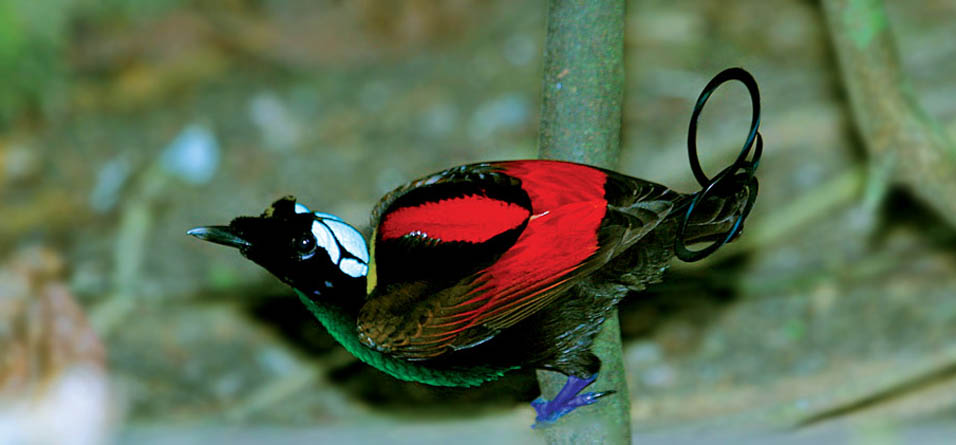 |
|||||
None of the spectacular birds-of-paradise surpass Wilson's Bird-of-Paradise in electric plumage (above). I've chosen it as the best passerine in the entire world (shown wonderfully in this photo, above, by Rob Hutchinson). It is limited in distribution to the islands of Waigeo and Batanta off the western tip of New Guinea. In the field the blue bare skin on the crown is so vivid you could read by it at night, the deep scarlet back and velvet green breast are lush, and the curlicue tail gleams bright silver. These outrageous colors and its remarkable display are shown in the BBC film Attenborough in Paradise. which was the first to obtain videos of this exotic creature. That film also delves into the history of western knowledge of these birds, which were once thought to exist only high above the earth, without feet or wings, and living on the dew of the heavens! Another unforgettable display is that of a a male King-of-Saxony Bird-of-Paradise (below in an excellent shot by K. David Bishop). With its two unbelievable head plumes that are held in a "V" above the head, quivering, when he goes into full display, it is also among the most astonishing of the birds-of-paradise. Its voice sounds like radio static. His enthusiasm is as energetic as any bop, and that is shown in the BBC film. |
|||||
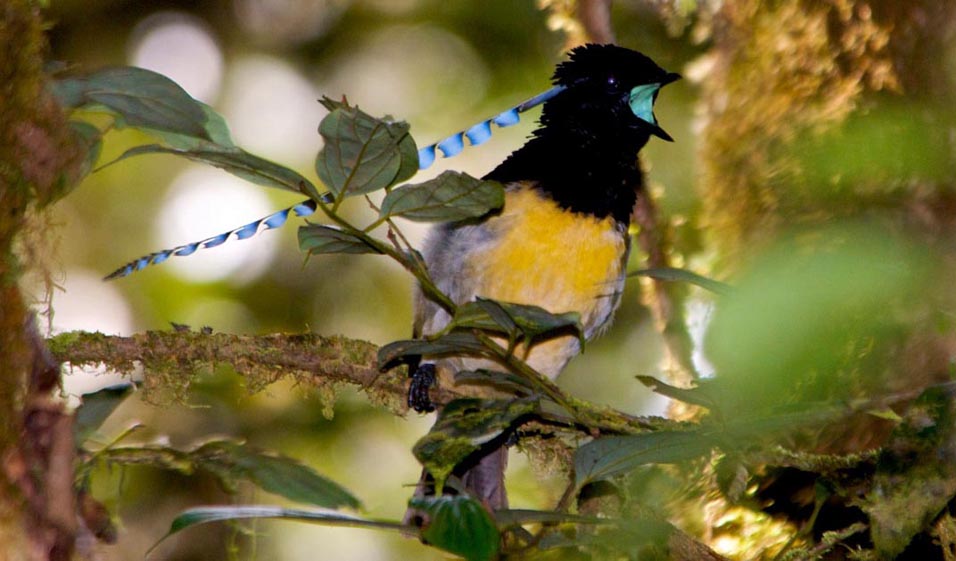 |
|||||
|
|||||
|
|||||
The BOPs that are called "sicklebills" are quite different birds in two different genera: Black-billed Sicklebill and Pale-billed Sicklebill in genus Drepanornis; and Black Sicklebill and Brown Sicklebill in genus Epimachus. The latter are large and very long-tailed species (as shown by the male Black Sicklebill in Will Betz' photo (above right). Female Epimachus sicklebills are quite lovely in her own plumages: a female Brown Sicklebill shows nicely in this shot (left). The patterns are rich and subtle, and just add more superlatives to any discussion of this family. Black-billed Sicklebill Drepanornis albertisi was once called "Buff-tailed Sicklebill." It and Pale-billed Sicklebill D. bruijnii are the two "short-tailed" sicklebills in the Paradisaeidae. They have long decurved bills but are smaller than the Epimachus sicklebills. Both are little-known and scarce species. During my first visit to Papua New Guinea in 1983, we had arranged to stay at a research station on Mt. Missim, where Bruce Beehler and S.G. Pruitt-Jones had a research plot to study birds-of-paradise, including Buff-tailed (now Black-billed) Sicklebill. We started a steep hike to the study plot with a local guide before dawn to reach to Sicklebill display tree at dawn. My 1983 notes read: "a male performing an inverted display high in a forest tree on Mt. Missim, at about 6000' elev., while giving loud "machine-gun" vocalizations while he spread his underwing plumes, was a highlight of the trip. Two other birds were present nearby." At the time we watched this dramatic display, it was undescribed in the literature, but papers describing the study plot and sicklebill display were published in due course (Beehler & Pruett-Jones 1983, Beehler 1987). Another wonderful BOP is the the sago palm swamp specialist, Twelve-wired Bird-of-Paradise Seleucidis melanoleuca — again, see the Attenborough film for astonishing video of its display and mating. Among other impressive BOPS are all of the five Astrapia whose long tail trains reach astonishing lengths. In my experience full adult males are quite shy and tend to be seen only a long distance away. Some females, though, come to montane lodges with feeders. This is a female Ribbon-tailed Astrapia (below). |
|||||
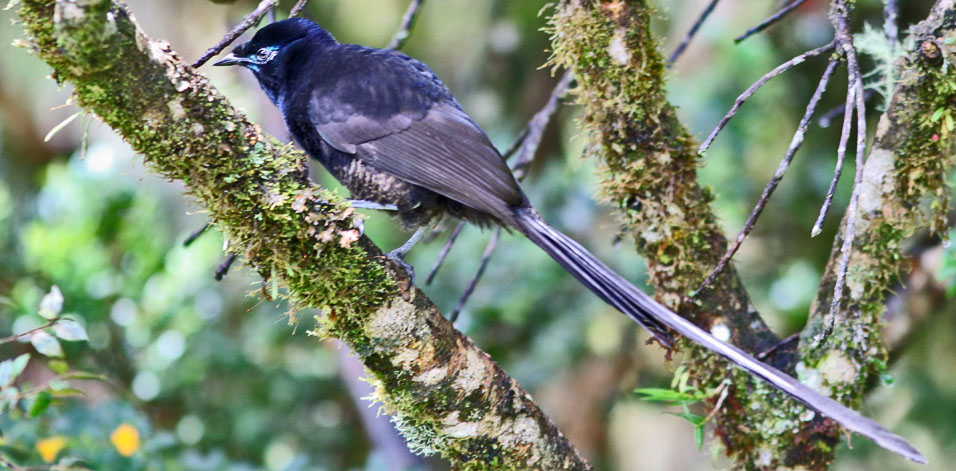 |
|
||||
Modified breast shields that form unworldly cravats are features of Wallace's Standardwing (of velvet green) and of what was once called the "Superb Bird-of-Paradise" (of glowing blue, left, in another great shot by Will Betz). Superb Bird-of-Paradise was recently split into 3 species and each of them was re-named as a Lophorina. This one (left) is now called Vogelkop Lophorina [unfortunately for me, I've only heard one]. The other species are Greater Lophorina L. superba — this is the widely distributed species in the central mountains of New Guinea — and Lesser Lophorina L. minor, farther east. Those BOPs in the genus Cicinnurus dance on courts that they clear on the forest floor. This includes Wilson's Bird-of-Paradise and Magnificent Bird-of-Paradise C. magnificus. An absolutely beautiful photo of the latter on a display court is in Coates (1990); there are wonderful shots of King Bird-of-Paradise C. regius at a forest pool there also. I have marveled at both of those species in the wild. More outstanding images of BOPs are in Frith & Frith (2009). Although I've emphasized the spectacular BOPs, and the extensive sexual dimorphism in these genera, there are primitive birds-of-paradise in which the sexes are similar. These are the five species of manucode (genus Manucodia) and also two paradigallas (Paradigalla). As would be expected when there is not sexual dimorphism, these species are monogamous and form pair bonds. This is quite unlike the promiscuous behavior of the rest of the family. Biochemical evidence (e.g., Sibley & Ahlquist 1990, Christidis & Schodde 1992, Nunn & Cracraft 1996, Cracraft & Feinstein 2000) shows that the manucode group are the only major lineage of birds-of-paradise that are a separate clade; they should probably be considered a subfamily of the Paradisaeidae. All the gorgeous, promiscuous BOPs are closely related, so much so that they may be better considered all the same genus. Under our current classification, there are many intergeneric hybrids known. This fact also suggests that all the famous BOPs are closely related despite their widely variable plumages. Molecular evidence, though, has clarified the status of some of the lesser known and more obscure species. Recent biochemical studies show that the three cnemophiline birds-of-paradise (genera Cnemophilus and Loboparadisea) are not closely related to BOPs at all (Cracraft & Feinstein 2000) and belong in their own family (Cnemophilidae). That same paper (Cracraft & Feinstein 2000) showed that "MacGregor's Bird-of-Paradise" Macgregoria pulchra was actually a giant honeyeater, close to Melipotes. That rather startling finding makes completely good sense to me — the bird was not like any other BOP. This means there are four fewer BOPs than had previously been thought. Frith & Beehler (1998), in their major review of this family, listed 42 biological species. [By contrast, Cracraft (1992) detailed about 90 "species" using the phylogenetic species concept.] I favor the biological species concept, so removing the 3 cnemophilines and MacGregor's leaves 38 BOPs in the Frith/Beehler review. Frith & Frith (2009) split the recently rediscovered Bronze Parotia Parotia berlepschi as the 39th BOP. And then the recent splits in riflebirds and Lophornias bring the total back of 42 species. All the traditional literature, and Sibley & Monroe (1990), included two species of Melampitta among the birds-of-paradise. These round-bodied, short-tailed, long-legged, ground-dwelling birds look rather like all-black ant-pittas. They are now assigned to their own family, the Melampittidae (Schodde & Christidis 2014). |
|||||
Photos: The Blue Bird-of-Paradise Paradisaea rudolphi, was photographed near Mt. Hagen on 11 Sep 2016. The displaying males and female Raggiana Bird-of-Paradise Paradisaea raggiana were at a lek in Varirata NP, Papua New Guinea, on xx 2016. Will Betz took the almost unbelievable photo of Carola's Parotia Parotia carolae in full display at 5500' elevation at Crater Mt. Wildlife Management Area, Papua New Guinea, in Oct 1997. Rob Hutchinson digitally captured the beautiful male Wilson's Bird-of-Paradise Cicinnurus respublica on Batanta I., West Papua, Indonesia, in May 2009. K. David Bishop photographed the displaying male King-of-Saxony Bird-of-Paradise Pteridophora alberti near Ambua Lodge, PNG, in Oct 2011. The displaying Lesser Bird-of-Paradise Paradisaea minor was photographed by Steve Wilson at Baiyer River Sanctuary, Papua New Guinea, on 25 Oct 1983. The photo of Wallace's Standardwing Semioptera wallacii was at Foli, Halmahera, Indonesia, on 9 Oct 2011 and the Paradise Crow Lycocorax pyrrhopterus was also at Foli a day later. Will Betz took the Black Sicklebill Epimachus meyeri photo at Crater Mt. WMA, PNG, in Oct 1997. The female Brown Sicklebill Epimachus meyeri was at the feeders at Kumal Lodge, PNG, on 12 Sep 2016, as was the female Ribbon-tailed Astrapia Astrapia mayeri. Hans & Judy Beste captured on film the female and displaying male Victoria Riflebird Ptilornis victoriae at Julatten, Queensland, Australia, in 1983. Will Betz photographed the displaying Vogelkop Lophorina Lophorina niebba in the Wandammen Mts., West Papua, Indonesia.
Family book: Rating
Family book: Rating
The book reviews above were posted on the first version of this family page in 1999, although I've slightly edited them again. Since that time, three new books on the Paradisaeidae have appeared. Here are capsule reviews of those recent publications by guest reviewer Murray Lord of Sydney, Australia: Family book: Rating
Family book: Rating
Family book: Rating
Literature cited:
|
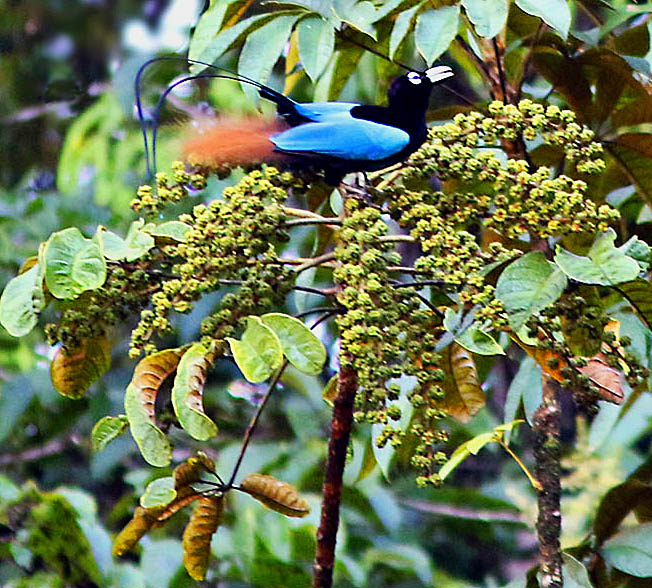 As a family the Paradisaeidae are perhaps most the impressive set of birds in the world. Yet they are just highly-modified corvoids (Sibley & Ahlquist 1990), a detail hinted at by their raucous cries. It is the variety and beauty of the plumes, shields, streamers, wires, and plumage of the males that is truly astonishing. And then there are the displays! The birds-of-paradise evolved in New Guinea, a land with abundant food but without mammalian predators. This permitted the development of a lek system with females selecting the most gaudy male.
As a family the Paradisaeidae are perhaps most the impressive set of birds in the world. Yet they are just highly-modified corvoids (Sibley & Ahlquist 1990), a detail hinted at by their raucous cries. It is the variety and beauty of the plumes, shields, streamers, wires, and plumage of the males that is truly astonishing. And then there are the displays! The birds-of-paradise evolved in New Guinea, a land with abundant food but without mammalian predators. This permitted the development of a lek system with females selecting the most gaudy male. 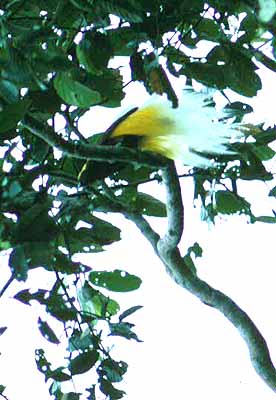 Until recently, I had not photographed any bird-of-paradise in the wild. My friend Steve Wilson photographed the wild displaying Lesser Bird-of-Paradise (left) during our 1983 visit to Papua New Guinea. I watched the latter bird — in its display tree at Baiyer River Sanctuary, back when that was a reasonably safe place to visit — as can be seen from the self-timer photo below (I'm flanked by Steve Wilson, left, and Chris Spooner, right).
Until recently, I had not photographed any bird-of-paradise in the wild. My friend Steve Wilson photographed the wild displaying Lesser Bird-of-Paradise (left) during our 1983 visit to Papua New Guinea. I watched the latter bird — in its display tree at Baiyer River Sanctuary, back when that was a reasonably safe place to visit — as can be seen from the self-timer photo below (I'm flanked by Steve Wilson, left, and Chris Spooner, right). 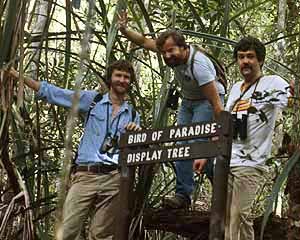
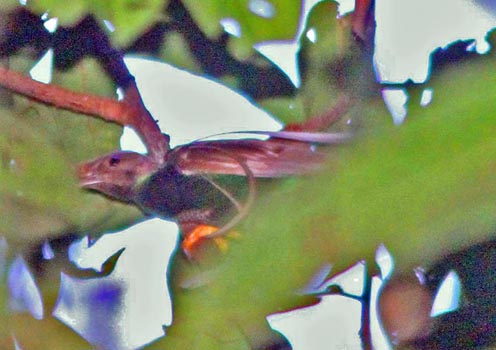
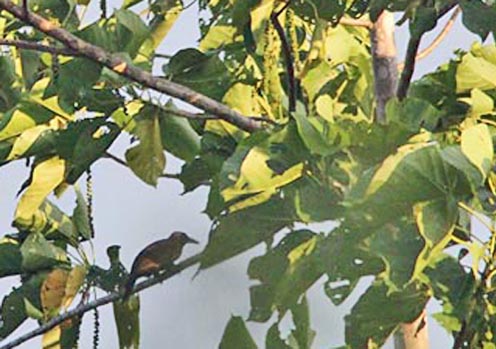

 Again, it is the BBC film Attenborough in Paradise that has remarkable footage of both of these species. The display of Wallace's Standardwing, which occurs very high in the canopy, was filmed with an ingenious rig. That footage including maneuvers made with the white "standards" attached to the front of its wing. That same Attenborough film has the dawn display of Black Sicklebill, another "top 50" bird, that truncates its body in full display in a way that is almost impossible to believe.
Again, it is the BBC film Attenborough in Paradise that has remarkable footage of both of these species. The display of Wallace's Standardwing, which occurs very high in the canopy, was filmed with an ingenious rig. That footage including maneuvers made with the white "standards" attached to the front of its wing. That same Attenborough film has the dawn display of Black Sicklebill, another "top 50" bird, that truncates its body in full display in a way that is almost impossible to believe.